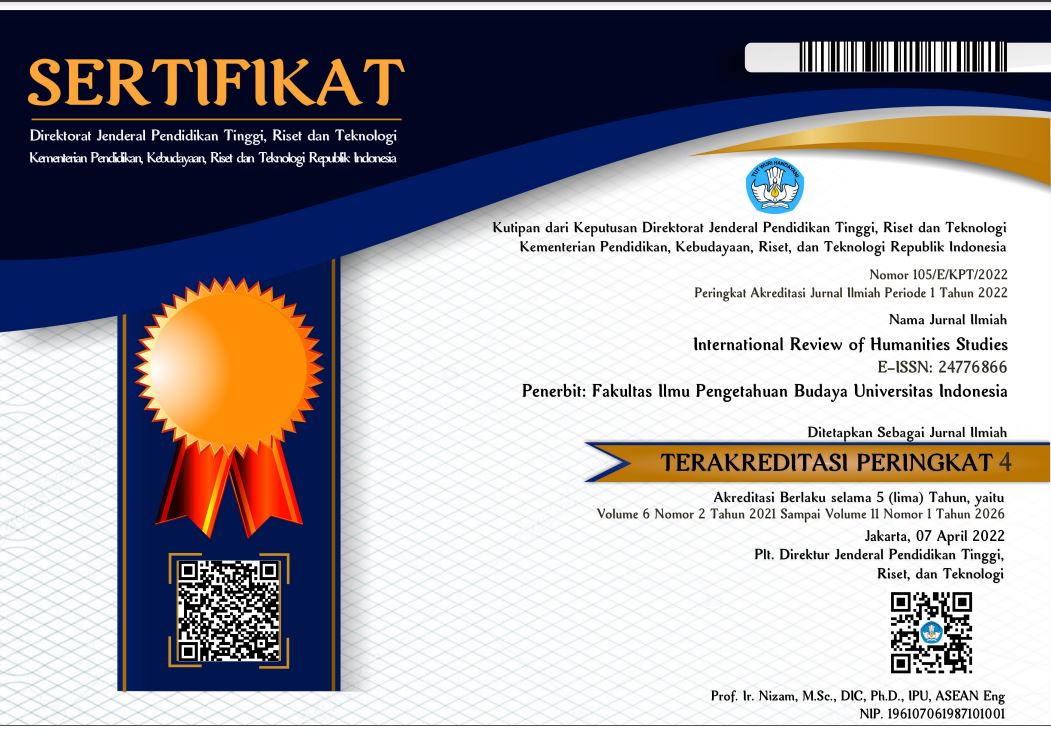International Review of Humanities Studies

Abstract
Chaos theory explicates how small things can result in big differences. Its basic principles can provide an alternative means for literary and non-literary interpretations. This study will explore how the principles of chaos theory can be utilized, together with commonly used literary theories, as an analytic lens to analyze the dramatic text of Shakespeare. The argument is built upon how Macbeth, viewed as a complex and chaotic system, become a strange attractor for both theater performances and cinematic adaptations, in an effort to understand the interconnection between the play and its reproductions as complex networks. Various elements of the text will be discussed, including its structure, language expressions and character patterning, as well as the choices of action – reaction determined to be taken by the characters in the play.
References
Babazadeh, Najaf Ali. (2017). “Repressive and Productive of Power in William Shakespeare's Macbeth” in International Journal of Scientific Study, July 2017, Vol. 5, Issue 4, pp. 132 – 139. Barthes, Roland. (1975). “An Introduction to the Structural Analysis of Narrative” in New Literary History, Vol. 6, No. 2, On Narrative and Narratives, pp. 237-272. Baltimore: John Hopkins University Press. Benner, Erica. (2017). Be Like the Fox: Machiavelli's Lifelong Quest for Freedom. London: Penguin. Boggs, Joseph M. & Dennis W. Petrie (2008). Art of Watching Films (7th edition). New York: McGraw-Hill. Boon, Kevin Alexander (1997), Chaos Theory and the Interpretation of Literary Texts: The Case of Kurt Vonnegut, Lewiston. NY: Edwin Mellen Press. Campbell, Lily B. (1961). Shakespeare’s Tragic Heroes. London: Methuen & Co, Ltd. Cox, John D. (1989). Shakespeare and the Dramaturgy of Power. Princeton: Princeton University Press. Dollimore, Jonathan. (2004). Radical Tragedy: Religion, Ideology and Power in the Drama of Shakespeare and His Contemporaries. New York: Palgrave MacMillan. Elam, Keir. (1980). The Semiotics of Theater and Drama. London: Methuen & Co, Ltd. Gleick, James (1998), Chaos: Making a New Science, London: Heinemann. Hawkins, Harriet. (1995). Strange Attractors: Literature, culture, and chaos theory. New York: Prentice Hall/Harvester Wheatsheaf. Hayles, N. Katherine. (1984). The Cosmic Web: Scientific Models and Literary Strategies in the Twentieth Century. Ithaca: Cornell University Press. ______. Chaos Bound: Orderly disorder in contemporary literature and science. Ithaca: Cornell University Press, 1990.Heller, Sharon. (2005). Freud, A to Z. New Jersey: John Wiley & Sons, Inc. Hutcheon, Linda. (2006). The Theory of Adaptation. New York: Routledge. Larsen-Freeman, D. (1997). “Chaos/complexity science and second language acquisition.” Applied Linguistics, 18, 141-165. Metz, Christian. (1974). Film Language: A Semiotics of the Cinema, trans. by Michael Taylor. New York: Oxford University Press. ______. (1974). Language and Cinema, trans. by Donna Jean Umiker-Sebeok. The Hague/Paris: Mouton. Roe, John. (2002). Shakespeare and Machiavelli. Cambridge: Cambridge University Press. Rybczak, Emil. (2015). “Hamlet, Performance and Chaotic Cultural Networks,” in Warwick Research Journal, 3 (1), 41-64. Sardar, Z., & Abrams, I. (1999). Introducing chaos. Cambridge, UK: Icon Books. Serres, Michel. (2002). Genesis, The University of Michigan Press. Silk, Michael. (2004) “Shakespeare and Greek Tragedy: Strange Relationship,” in Shakespeare and the Classics, ed. Charles Martindale and A.B. Taylor. Cambridge: Cambridge University Press, 241.
Recommended Citation
Soenarto, Iswahyudi and Wibawarta, Bambang
(2023)
"SHAKESPEARE’S TRAGEDY OF MACBETH AS A STRANGE ATTRACTOR FOR THEATER PERFORMANCES AND CINEMATIC ADAPTATIONS,"
International Review of Humanities Studies: Vol. 8:
No.
2, Article 19.
DOI: 10.7454/irhs.v8i2.1124
Available at:
https://scholarhub.ui.ac.id/irhs/vol8/iss2/19


